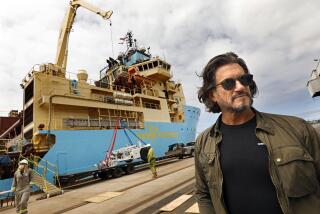Researchers Expecting Big Things From Lowly Marine Algae
SANTA CRUZ — A drug that could save your life may be hiding right now in a bit of ordinary seaweed.
So could chemicals that could produce better crops, kill dangerous pests or clean toxic wastes. They just haven’t been discovered yet.
“We’re essentially land creatures. That’s why we’ve focused on land plants. But the sea, chemically, is a very different environment, and you will find many new and different things there,” said Kenneth Terry, vice president of Ocean Genetics Inc.
The young company 60 miles south of San Francisco wants to be the first to find, develop and perhaps market some of the potentially valuable products that may be lurking in seaweed and other forms of marine algae.
In hundreds of glass dishes and flasks in its laboratories, or in huge bubbling tanks in seaside greenhouses, Ocean Genetics is growing, studying and testing more than 300 species of the simple plants.
Algae, which range from one-celled organisms to large, familiar seaweeds, already are used to make many things, including stabilizers, thickeners and texturizers important in the food and cosmetic industries and gels essential to science and medicine. Two of those gels are agar--the familiar culture medium in petri dishes--and its purer, electrically neutral form, agarose, which is crucial to many research procedures.
There are no substitutes for either, producers are few, and demand keeps growing. That means a profitable opportunity for Ocean Genetics, which plans later this year to market the agar and agarose that it is now producing.
“Agar and agarose provide us with the steppingstone I felt was necessary for Ocean Genetics to find and develop other product lines,” said company president and founder Wayne Harvey.
Those yet-undiscovered products are the primary, though long-term, goal of the company, its officials said.
“The highest potential is for pharmaceutical and animal health-care products. But I think the potential of agrichemicals, in particular natural pesticides . . . and plant-growth regulators, also are significant,” Harvey said.
Bay Venture Group, which provided Ocean Genetics with $200,000 in seed capital when it was formed in 1981 and with other financing since, is pleased with the privately held company’s progress and is optimistic about its future.
“It has all the characteristics of a successful business,” said Bay Venture general partner Bill Chandler, also a director of Ocean Genetics. “I think the company is going to be a major pioneer.
“And of course there’s a saying that while pioneers get shot in the back, they also get to claim the new land.”
Once it identifies new chemicals, Ocean Genetics will be able to grow the algae they come from very quickly, Harvey said.
That’s primarily because the company combines engineering knowledge with plant physiology and biochemistry and will avoid “the vagaries of nature” by raising large monoculture crops of proven plants in indoor tanks, he said.
But the process begins in a Santa Cruz laboratory filled with hundreds of petri dishes and seething carboys filled with large pieces of brown, red and green algae.
The specimens, collected all over the world, are cleaned and small pieces are put in the petri dishes, where they grow for several months. Then they are transferred to the carboy containers, where for another six to nine months they are kept in purified, nutrient-rich salt water.
“Once we have found an organism that produces a product, we do extensive studies . . . to find out how we can control its environment to maximize the production and the quality of what we’re interested in,” Harvey said.
Controlling reproduction, screening cells for mutations and cloning are some of the methods the company can use to increase and improve desirable qualities, he added.
Ocean Genetics’ first research product, phychobiliproteins, already is being produced and tested. The naturally fluorescent chemicals found in certain seaweeds can be used in medicine to tag some types of cells. Someday they may replace the radioactive tracers now used to study and treat diseases like cancer and AIDS, Harvey said.
“These little puppies are worth $10,000 to $15,000 a gram--wholesale,” he said, holding a test tube of glowing purple liquid.
After growing in the carboys, some plants are freeze-dried and sent to one of several pharmaceutical, chemical or biotech companies, which test the samples for possibly valuable substances.
But other promising varieties are “grown up” and studied further in several stages in computer-controlled tanks inside greenhouses on land the company leases from UC Santa Cruz, Terry said.
Reaching into one tank, Terry pulled out a handful of material that looked like reddish-brown steel wool--a plant whose origin or possible future use he and Harvey good-naturedly refused to reveal.
“This is a unique opportunity,” Terry said. “It’s about as if we were able to start over on land. The sea is a whole fresh resource.”





